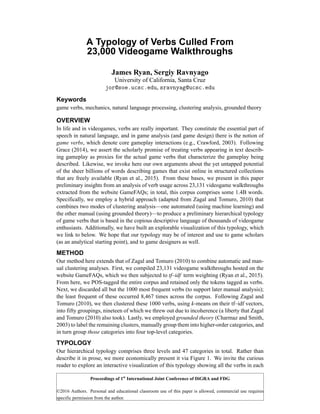
verbs_used_in_walkthroughs
- 1. A Typology of Verbs Culled From 23,000 Videogame Walkthroughs James Ryan, Sergiy Ravnyago University of California, Santa Cruz , Proceedings of 1st International Joint Conference of DiGRA and FDG ©2016 Authors. Personal and educational classroom use of this paper is allowed, commercial use requires specific permission from the author. Keywords game verbs, mechanics, natural language processing, clustering analysis, grounded theory OVERVIEW In life and in videogames, verbs are really important. They constitute the essential part of speech in natural language, and in game analysis (and game design) there is the notion of game verbs, which denote core gameplay interactions (e.g., Crawford, 2003). Following Grace (2014), we assert the scholarly promise of treating verbs appearing in text describ- ing gameplay as proxies for the actual game verbs that characterize the gameplay being described. Likewise, we invoke here our own arguments about the yet untapped potential of the sheer billions of words describing games that exist online in structured collections that are freely available (Ryan et al., 2015). From these bases, we present in this paper preliminary insights from an analysis of verb usage across 23,131 videogame walkthroughs extracted from the website GameFAQs; in total, this corpus comprises some 1.4B words. Specifically, we employ a hybrid approach (adapted from Zagal and Tomuro, 2010) that combines two modes of clustering analysis—one automated (using machine learning) and the other manual (using grounded theory)—to produce a preliminary hierarchical typology of game verbs that is based in the copious descriptive language of thousands of videogame enthusiasts. Additionally, we have built an explorable visualization of this typology, which we link to below. We hope that our typology may be of interest and use to game scholars (as an analytical starting point), and to game designers as well. METHOD Our method here extends that of Zagal and Tomuro (2010) to combine automatic and man- ual clustering analyses. First, we compiled 23,131 videogame walkthroughs hosted on the website GameFAQs, which we then subjected to tf–idf term weighting (Ryan et al., 2015). From here, we POS-tagged the entire corpus and retained only the tokens tagged as verbs. Next, we discarded all but the 1000 most frequent verbs (to support later manual analysis); the least frequent of these occurred 8,467 times across the corpus. Following Zagal and Tomuro (2010), we then clustered these 1000 verbs, using k-means on their tf–idf vectors, into fifty groupings, nineteen of which we threw out due to incoherence (a liberty that Zagal and Tomuro (2010) also took). Lastly, we employed grounded theory (Charmaz and Smith, 2003) to label the remaining clusters, manually group them into higher-order categories, and in turn group those categories into four top-level categories. TYPOLOGY Our hierarchical typology comprises three levels and 47 categories in total. Rather than describe it in prose, we more economically present it via Figure 1. We invite the curious reader to explore an interactive visualization of this typology showing all the verbs in each
- 2. Development Construction Collection gather, stack Improvement build, upgrade Domestic cook, grow, water Attributes Adjustment increase, reduce Acquisition/Transaction buy, earn, equip Crafting/Spellcasting bless, craft, spell Achievement achieve, surpass Competition Competitive Strategy Operations design, function Logistics manage, plan Warfare Tactics capture, deploy Warfare Patterns battle, paralyze Physical Combat Basic Combat kick, punch Combat Timing block, counter Weaponized Combat Gun Combat aim, reload, snipe Deformation melt, sink, warp Movement Locomotion Swift Movement dash, lunge Vertical Movement ascend, climb Acrobatics bounce, roll Reaction duck, sidestep Skateboarding grind, skate Object Movement deflect, hurl Exploration General Exploration explore, wander Stealth Concealment conceal, disguise Sneakiness hide, sneak, wait Racing Vehicle Control brake, drift Psychosocial Analysis Examination examine, view Investigation arrest, question Emotion Aggression bite, scream Feeling cry, love Social Affective Reaction laugh, smile Relations listen, trust Figure 1: Our hierarchical typology, with example verbs for each low-level category. category (and their associated games), which we have made available at . BIBLIOGRAPHY Charmaz, K. and J. Smith (2003). Grounded theory. Qualitative Psychology. Crawford, C. (2003). Chris Crawford on game design. New Riders. Grace, L. D. (2014). A linguistic analysis of mobile games: Verbs and nouns for content estimation. In Proc. Foundations of Digital Games. Ryan, J. O., E. Kaltman, M. Mateas, and N. Wardrip-Fruin (2015). What we talk about when we talk about games: Bottom-up game studies using natural language processing. In Proc. Foundations of Digital Games. Zagal, J. P. and N. Tomuro (2010). The aesthetics of gameplay: a lexical approach. In Proc. Academic MindTrek. –2–